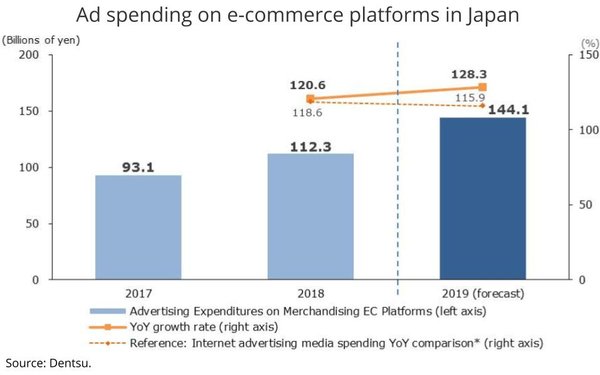Commentary
It's The Ecommerce, Stupid
- by Joe Mandese @mp_joemandese, July 29, 2019

One of the media industry’s biggest ad categories has always been, well, media. So an analysis released early this morning that shows digital ecommerce platforms are driving some of the greatest ad spending growth in Japan caught my attention.
This self-proclaimed “first ever” analysis of what’s going on in one of the world’s largest ad markets was compiled by three Dentsu entities in Japan, including D2C Inc., Cyber Communications Inc. and Dentsu Inc.
It is another confirmation of an increasingly dominant virtuous cycle: Digital media has spurred demand for real-time, frictionless commerce online, which in turn, has spurred ad spending to drive even more online commerce.
advertisement
advertisement
While the Dentsu analysis doesn’t explicitly address one of the most disruptive trends in digital commerce -- the emergence of D2C brands -- it offers another example of the increasingly critical virtuous cycle also alluded to in another recent report, from GroupM’s Brian Wieser.
That cycle: Digital media has spurred demand for real-time, frictionless commerce online, which in turn, has spurred even more ad spending, particularly in digital media, to drive even more online commerce.
The dynamic's implications are “twofold,” Wieser wrote. “It shapes the behaviors of consumers and manufacturers, and it also has a significant impact on the media industry because of the different ways advertising is used to support different kinds of ecommerce activity. Consequently, variations in growth between... D2C, first-party online retail and third-party marketplaces are important to monitor.”
While the growth rate of the ecommerce boom is decelerating, according to Wieser’s analysis, it remains one of the biggest growth engines of digital ad spending. At least part of that is coming from D2C brands that bypass normal product distribution chains altogether.
Wieser’s report digs deep into ecommerce trends to identify newer, emerging patterns that could be both a boom and a disruptor, such as the emergence of “marketplaces,” which are endemic commerce platforms created by media owners themselves to generate ad revenue from manufacturers they work with directly.
All of this activity is also spawning a tremendous amount of ad spending that doesn’t normally show up “above the line,” such as the massive “co-op” ad budgets big manufacturers spend in retail, and increasingly in electronic retail. This is one of the reasons Amazon has emerged as the third-largest digital ad company, just behind Google and Facebook, in the past couple of years.
The increasingly role of ecommerce -- whether it's conventional platforms like Amazon, D2C brands or media marketplaces -- requires a shift in strategic planning at both brands and agencies. Wieser notes: "Retail planning" is now required early in the product and marketing planning process.
“Retail amplification -- both paid media and reviews -- is critical, but it depends heavily on planning and optimization as a starting point,” Wieser advocates. “Understanding growth trends underlying ecommerce-related advertising can help to support this latter objective by identifying which media are likely to fare relatively better or relatively worse into the future," he adds.



